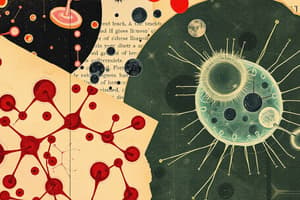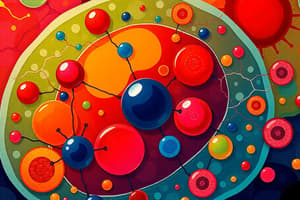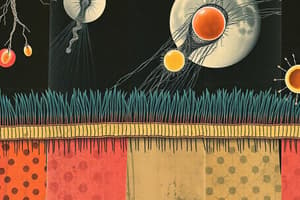Podcast
Questions and Answers
Which organelle is responsible for generating energy in the form of ATP through cellular respiration?
Which organelle is responsible for generating energy in the form of ATP through cellular respiration?
- Golgi Apparatus
- Endoplasmic Reticulum
- Nucleus
- Mitochondria (correct)
The cell membrane is primarily responsible for synthesizing proteins.
The cell membrane is primarily responsible for synthesizing proteins.
False (B)
What are the two main types of Endoplasmic Reticulum (ER) and what are their primary functions?
What are the two main types of Endoplasmic Reticulum (ER) and what are their primary functions?
The two main types of ER are the rough ER and the smooth ER. The rough ER is responsible for synthesizing proteins, while the smooth ER synthesizes lipids and detoxifies substances.
During ______, the chromosomes condense and become visible.
During ______, the chromosomes condense and become visible.
Match the following cell structures with their primary functions:
Match the following cell structures with their primary functions:
What is the primary function of White Blood Cells (WBCs)?
What is the primary function of White Blood Cells (WBCs)?
Cancer cells have a controlled growth pattern and can specialize in specific functions.
Cancer cells have a controlled growth pattern and can specialize in specific functions.
What are the two main treatments for cancer that use drugs and radiation?
What are the two main treatments for cancer that use drugs and radiation?
Red blood cells have a lifespan of approximately ______ days.
Red blood cells have a lifespan of approximately ______ days.
Match the following types of stem cells with their characteristics:
Match the following types of stem cells with their characteristics:
Flashcards
Nucleus
Nucleus
The control center of the cell, containing DNA and directing cell activities.
Cell Membrane
Cell Membrane
A thin barrier that regulates what enters and exits the cell, protecting it from its environment.
Cytoplasm
Cytoplasm
The jelly-like substance that fills the cell, holding organelles and supporting chemical reactions.
Mitochondria
Mitochondria
Signup and view all the flashcards
Endoplasmic Reticulum (ER)
Endoplasmic Reticulum (ER)
Signup and view all the flashcards
Ribosomes
Ribosomes
Signup and view all the flashcards
Golgi Apparatus
Golgi Apparatus
Signup and view all the flashcards
Lysosomes
Lysosomes
Signup and view all the flashcards
What do red blood cells do?
What do red blood cells do?
Signup and view all the flashcards
What is the role of white blood cells?
What is the role of white blood cells?
Signup and view all the flashcards
What do platelets do?
What do platelets do?
Signup and view all the flashcards
How are cancer cells different from normal cells?
How are cancer cells different from normal cells?
Signup and view all the flashcards
What are stem cells?
What are stem cells?
Signup and view all the flashcards
Study Notes
Cell Parts and Functions
- Nucleus: Controls cell activities, stores DNA
- Cell Membrane: Regulates substance movement in and out of the cell, provides protection
- Cytoplasm: Holds organelles, supports chemical reactions
- Mitochondria: Generates energy (ATP) through cellular respiration, regulates metabolism
- Endoplasmic Reticulum (ER): Rough ER synthesizes proteins, smooth ER synthesizes lipids and detoxifies substances
- Ribosomes: Synthesize proteins from amino acids
- Golgi Apparatus: Modifies, packages, and transports proteins and lipids produced by the ER
- Lysosomes: Contain enzymes that digest waste, old cell parts, and foreign invaders
- Vacuoles: Store nutrients, waste products, maintain cell shape (larger in plant cells)
- Cytoskeleton: Provides structural support, shape, and aids in cell movement
- Centrioles: Organize spindle fibers during cell division in animal cells
- Chloroplasts: Perform photosynthesis, converting light energy into chemical energy (in plant cells)
- Cell Wall: Provides structural support and protection, maintains cell shape (in plant cells)
Organ Systems
- Circulatory System: Heart pumps blood, arteries carry oxygenated blood, and veins carry deoxygenated blood
- Digestive System: Organs like mouth, esophagus, stomach, and intestines that break down food for absorption
- Respiratory System: Organs like nose, trachea, lungs, and alveoli involved in gas exchange (oxygen intake and carbon dioxide release)
Cell Cycle and Mitosis
- Interphase: Cell growth and preparation for division
- Mitosis:
- Prophase: Chromosomes condense
- Metaphase: Chromosomes align in the middle
- Anaphase: Chromosomes separate
- Telophase: Nuclear membranes reform
- Cytokinesis: Division of the cytoplasm
Microscope Calculations
- To convert millimeters to micrometers, multiply by 1000
- Field of View (FOV): Use formulas to calculate FOV at different magnifications (e.g., low power, high power)
Cell Types (Size & Function)
- Red Blood Cells (RBCs): Transport oxygen, contain hemoglobin, lifespan ~120 days
- White Blood Cells (WBCs): Fight infections (types include lymphocytes and neutrophils)
- Platelets: Help in blood clotting, lifespan 7-10 days
Cancer and Normal Cells
- Normal Cells: Controlled growth, specialize in functions, die naturally when damaged/old (apoptosis)
- Cancer Cells: Uncontrolled growth, fail to specialize, remain immature, invade surrounding tissues (metastasis)
Causes and Treatment of Cancer
- Causes: Genetic mutations, environmental factors, carcinogens
- Treatments: Surgery, chemotherapy, radiation therapy, immunotherapy
Specialized Cells
- Nerve Cells (Neurons): Transmit signals
- Muscle Cells: Contract for movement
- Red Blood Cells: Transport oxygen
Stem Cells
- Definition: Undifferentiated cells that can become specialized cells
- Types: Embryonic stem cells (can become any cell type), adult/tissue stem cells (specialize in limited cell types)
Organ Transplantation
- Definition: Replacing a failing or damaged organ with a donor organ
- Donor Types: Living donors, deceased donors (kidney, liver, lung, bone marrow, heart, pancreas, intestines)
Studying That Suits You
Use AI to generate personalized quizzes and flashcards to suit your learning preferences.




